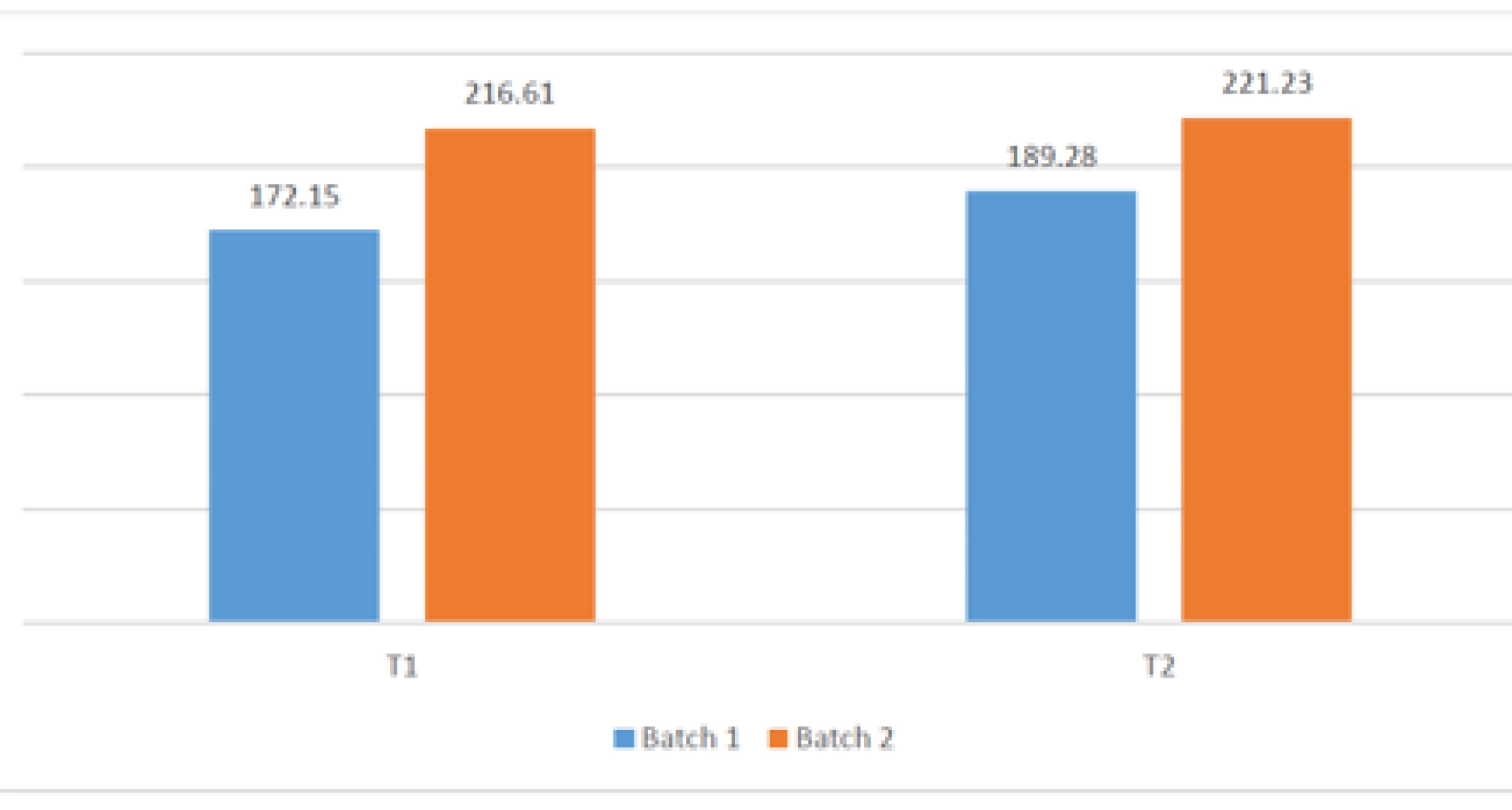
Effect of Ferticote Carbon Coated Fertilizer (CCF) Fertilization on the Growth of Acacia crassicarpa.
Acacia crassicarpa fertilized using CCF Ferticote as basic fertilizer, had a higher plant height and larger stem diameter than plants using ordinary granular NPK fertilizer with specifications 15.15.15.
Fertilization activity is necessary for optimum plant bio-mass production. The purpose of this experiment was to examine the effect of CCF Ferticote fertilizer application on the growth of forestry plants, especially from the species Acacia crassicarpa. The experiment took place in the concession area of an industrial forest plantation (IFP) in Siak Regency.
Carbon Coated Fertilizer (CCF) Ferticote is an NPK fertilizer that is assembled with special technology to reach the macro and micronutrient needs of forestry plants. This NPK fertilizer is equipped with ACTIVE CARBON, an adsorbent derived from the pyrolysis process of biomass. Has the ability to absorb protein and contains paramagnetic compounds.Act as a slow release of ammonium and nitrate. A system that captures soil humic acid and is a breeding ground for bacteria. In addition, this fertilizer also contains HUMIC ACID, a natural soil enhancer that acts as a natural chelating agent and microbial stimulant. Humic acid increases the ability of plants to absorb essential nutrients and improve soil structure.
Combination of activated carbon and humic acid plays a role in increasing soil carbon, chelating macro, and micro nutrients to increase availability to plants for a longer period of time, increasing soil CEC, stimulating soil bacterial growth.
METHODOLOGY
The experiment was divided into two batches. Batch 1 started in June 2013, while Batch 2 with the aim of verifying data Batch 1 started in December 2013.
The type of plant that used is Acacia crassicarpa. Fertilizers experiment are given to seedlings that have just been planted in the field (when transplanting). The soil type at the experimental site belongs to the order Histosol (Peat).
The treatment given to the plant is as follows:
Batch 1
T1. Ash 1 Kg + RP 150 gr + NPK 15.15.15 100 gr
T2. Ash 1 Kg + RP 150 gr + CCF Ferticote 50 gr
T3. Ash 1 Kg + RP 150 gr + CCF Ferticote 75 gr
T4. Ash 1 Kg + RP 150 gr + CCF Ferticote 100 gr
Batch 2
T1. Ash 1 Kg + RP 150 gr + NPK 15.15.15 100 gr
T2. Ash 1 Kg + RP 150 gr + CCF Ferticote 50 gr
For the treatment in the Batch 2 experiment, T1 and T2 treatments were chosen with the goals to verify the results of the Batch 1 experiment where at a dose of 50 g/principal, CCF Ferticote was able to give better results than NPK 15.15.15 fertilizer at a dose of 100 g/principal.
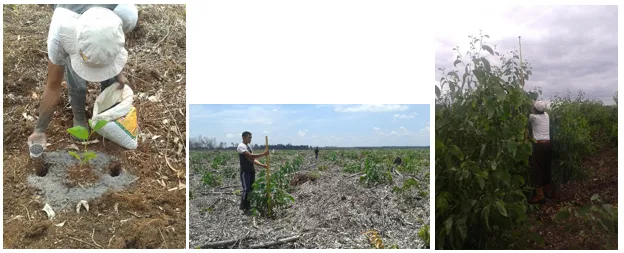
(Left) Acacia crassicarpa at planting and application of CCF Ferticote (Middle) Observation of plant height at 3 months (Right) Plants at 6 months.
Fertilizer is applied by spot placement, fertilizer is sown in the holes on the left and right of the plant. Observations were made by taking 25 sample plants in each plot. Parameters and observation time are:
Plant Height : Age 3, 6, and 12 Months after planting
Stem Diameter : 12 months after planting
RESULTS AND DISCUSSION
Batch 1
At the age of 12 months, all treatments using CCF Ferticote (T2, T3, and T4) gave better results than Acacia crassicarpa has given NPK 15.15.15 fertilizer. The best results were shown by treatment T4 (100 g CCF Ferticote/plant) for plant height parameters and T3 treatment (75 g CCF Ferticote/plant) for stem diameter parameters.
In the plant height parameter, there was the consistency of data where, the greater the dose of CCF Ferticote given, the higher the Acacia crassicarpa produced. Meanwhile, the diameter of the stem at T4 experienced a large decrease in diameter. This requires further study.
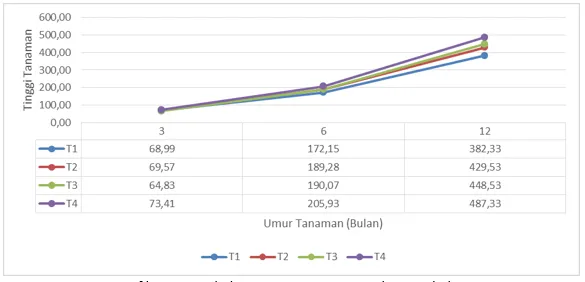
Graph 1. Growth of Acacia crassicarpa for 12 months
The pattern of plant height growth shown in the 4 treatments in this experiment showed a consistent pattern where the T2, T3, and T4 treatments always gave better results than T1 each time. At the age of 3 months, the plant height of T3 was lower than that of T2. This happened because, in one of the T3 replication plots, many plants had stunted growth due to drought stress that occurred in the period June-August 2013. At the age of 6 months (September 2013), the growth pattern of the 4 treatments returned to normal.
Batch 2
As a verification of the results of the experiment which began in June 2013, Batch 2 has been carried out which began in December 2013. The data in graph 2 shows that the plants tested in Batch 2 gave better results than Batch 1. For comparisons between treatments still showed consistent results where Acacia crassicarpa given CCF Ferticote showed higher plant height than those given NPK 15.15.15.
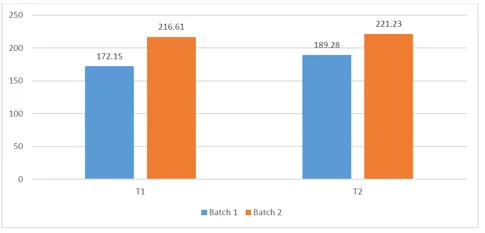
Graph 2. Comparison of plant heights of Acacia crassicarpa aged 6 months between Experiments Batch 1 and 2.
CONCLUSION
The use of CCF Ferticote as a basic NPK fertilizer in the cultivation of Acacia crassicarpa gave better results than the use of NPK 15.15.15 fertilizer at a dose of 100 g/tree. Ferticote CCF fertilizer can be applied at dosage levels of 50, 75, or 100 g/tree depending on the desired results.
***
Fertilization activity is necessary for optimum plant bio-mass production. The purpose of this experiment was to examine the effect of CCF Ferticote fertilizer application on the growth of forestry plants, especially from the species Acacia crassicarpa. The experiment took place in the concession area of an industrial forest plantation (IFP) in Siak Regency.
Carbon Coated Fertilizer (CCF) Ferticote is an NPK fertilizer that is assembled with special technology to reach the macro and micronutrient needs of forestry plants. This NPK fertilizer is equipped with ACTIVE CARBON, an adsorbent derived from the pyrolysis process of biomass. Has the ability to absorb protein and contains paramagnetic compounds.Act as a slow release of ammonium and nitrate. A system that captures soil humic acid and is a breeding ground for bacteria. In addition, this fertilizer also contains HUMIC ACID, a natural soil enhancer that acts as a natural chelating agent and microbial stimulant. Humic acid increases the ability of plants to absorb essential nutrients and improve soil structure.
Combination of activated carbon and humic acid plays a role in increasing soil carbon, chelating macro, and micro nutrients to increase availability to plants for a longer period of time, increasing soil CEC, stimulating soil bacterial growth.
METHODOLOGY
The experiment was divided into two batches. Batch 1 started in June 2013, while Batch 2 with the aim of verifying data Batch 1 started in December 2013.
The type of plant that used is Acacia crassicarpa. Fertilizers experiment are given to seedlings that have just been planted in the field (when transplanting). The soil type at the experimental site belongs to the order Histosol (Peat).
The treatment given to the plant is as follows:
Batch 1
T1. Ash 1 Kg + RP 150 gr + NPK 15.15.15 100 gr
T2. Ash 1 Kg + RP 150 gr + CCF Ferticote 50 gr
T3. Ash 1 Kg + RP 150 gr + CCF Ferticote 75 gr
T4. Ash 1 Kg + RP 150 gr + CCF Ferticote 100 gr
Batch 2
T1. Ash 1 Kg + RP 150 gr + NPK 15.15.15 100 gr
T2. Ash 1 Kg + RP 150 gr + CCF Ferticote 50 gr
For the treatment in the Batch 2 experiment, T1 and T2 treatments were chosen with the goals to verify the results of the Batch 1 experiment where at a dose of 50 g/principal, CCF Ferticote was able to give better results than NPK 15.15.15 fertilizer at a dose of 100 g/principal.

(Left) Acacia crassicarpa at planting and application of CCF Ferticote (Middle) Observation of plant height at 3 months (Right) Plants at 6 months.
Fertilizer is applied by spot placement, fertilizer is sown in the holes on the left and right of the plant. Observations were made by taking 25 sample plants in each plot. Parameters and observation time are:
Plant Height : Age 3, 6, and 12 Months after planting
Stem Diameter : 12 months after planting
RESULTS AND DISCUSSION
Batch 1
At the age of 12 months, all treatments using CCF Ferticote (T2, T3, and T4) gave better results than Acacia crassicarpa has given NPK 15.15.15 fertilizer. The best results were shown by treatment T4 (100 g CCF Ferticote/plant) for plant height parameters and T3 treatment (75 g CCF Ferticote/plant) for stem diameter parameters.
In the plant height parameter, there was the consistency of data where, the greater the dose of CCF Ferticote given, the higher the Acacia crassicarpa produced. Meanwhile, the diameter of the stem at T4 experienced a large decrease in diameter. This requires further study.

Graph 1. Growth of Acacia crassicarpa for 12 months
The pattern of plant height growth shown in the 4 treatments in this experiment showed a consistent pattern where the T2, T3, and T4 treatments always gave better results than T1 each time. At the age of 3 months, the plant height of T3 was lower than that of T2. This happened because, in one of the T3 replication plots, many plants had stunted growth due to drought stress that occurred in the period June-August 2013. At the age of 6 months (September 2013), the growth pattern of the 4 treatments returned to normal.
Batch 2
As a verification of the results of the experiment which began in June 2013, Batch 2 has been carried out which began in December 2013. The data in graph 2 shows that the plants tested in Batch 2 gave better results than Batch 1. For comparisons between treatments still showed consistent results where Acacia crassicarpa given CCF Ferticote showed higher plant height than those given NPK 15.15.15.

Graph 2. Comparison of plant heights of Acacia crassicarpa aged 6 months between Experiments Batch 1 and 2.
CONCLUSION
The use of CCF Ferticote as a basic NPK fertilizer in the cultivation of Acacia crassicarpa gave better results than the use of NPK 15.15.15 fertilizer at a dose of 100 g/tree. Ferticote CCF fertilizer can be applied at dosage levels of 50, 75, or 100 g/tree depending on the desired results.
***
More News
 PT Nusa Palapa Gemilang Tbk (NPGF) Reports Financial Performance for the Third Quarter of 2024
PT Nusa Palapa Gemilang Tbk (NPGF) Reports Financial Performance for the Third Quarter of 2024Surabaya, October 30, 2024 – PT Nusa Palapa Gemilang Tbk (“NPGF”), a publicly listed company specializing in agricultural chemicals and fertilizers, announced its financial performance report for the third quarter of 2024 on October 29, 2024. This report reflects the Company’s efforts to maintain business stability amid market challenges while reinforcing its commitment to sustainable growth.
Key Financial Achievements
In the third quarter of 2024, NPGF recorded several significant financial achievements, including:
• Revenue Growth: As of the end of September 2024, the Company recorded revenue of IDR 100.77 billion, marking a substantial increase of IDR 81.17 billion compared to the revenue of IDR 19.60 billion at the end of September 2023. This achievement was primarily driven by increased demand for the Company’s flagship products, such as NPK granular fertilizers, NPK briquettes, and micronutrient fertilizers.
• Operating Profit: The Company’s operating profit as of the end of September 2024 reached IDR 8.36 billion, reflecting a significant growth of 145.28% or IDR 26.82 billion compared to the same period last year, when the Company recorded an operating loss of IDR 18.46 billion.
• EBITDA: The Company recorded an EBITDA of IDR 10.40 billion, marking a growth of 94.32% compared to EBITDA in the second quarter of 2024. This achievement reflects a solid financial position supporting the Company’s long-term growth initiatives.
• Net Profit: The Company successfully recorded a net profit of IDR 3.37 billion, representing a significant increase of 2.17 times compared to the net profit in the second quarter of 2024, which was IDR 1.06 billion.
Growth Supporting Factors
The Company has successfully strengthened its market position through various strategies, including:
• Market Diversification: NPGF has expanded its market reach, targeting not only the corporate segment but also the retail segment, aiming to reach a broader customer base and increase product accessibility. The Company is now actively entering the retail market, offering products tailored to the needs of individual farmers and end consumers, thereby enhancing its position within the agriculture industry as a whole.
• Operational Efficiency: The implementation of new technology and supply chain optimization has become a key factor in reducing production costs, contributing to increased operating profit.
• Commitment to Sustainability: NPGF is also committed to adopting sustainable practices.
Projection and Strategic Plan
The Company's fiscal target for 2024 is to increase revenue by 187% compared to the previous year. As we approach the final quarter of 2024, NPGF remains optimistic about further enhancing performance by focusing on market expansion and strengthening relationships with key customers. The Company plans to increase production capacity at several main facilities and expand its distribution network across Indonesia.
About PT Nusa Palapa Gemilang Tbk
The Company has been operating since 2001, specializing in the production, marketing, and trading of compound fertilizers with primary macro-nutrient content. In 2023, PT Nusa Palapa Gemilang Tbk began producing NPK fertilizers using the dry granulation system. NPGF was listed as a public company on the Indonesia Stock Exchange on April 14, 2021. With years of experience and a dedication to innovation, the Company remains committed to delivering the best products and services to its customers.
For further information, please contact:
Corporate Secretary
T +6231 8485665 | F +6231 8495095
corporatesecretary@ptnpg.com
www.ptnpg.com
This press release was prepared by PT Nusa Palapa Gemilang Tbk. ("NPGF") and is intended purely for general informational purposes. It does not imply a recommendation for NPGF shares. NPGF assumes no responsibility for any repercussions resulting from reliance on all or any part of the contents of this press release. Neither NPGF, its affiliates, nor their respective employees and agents assume responsibility for any errors, omissions, or inaccuracies that may occur...
Key Financial Achievements
In the third quarter of 2024, NPGF recorded several significant financial achievements, including:
• Revenue Growth: As of the end of September 2024, the Company recorded revenue of IDR 100.77 billion, marking a substantial increase of IDR 81.17 billion compared to the revenue of IDR 19.60 billion at the end of September 2023. This achievement was primarily driven by increased demand for the Company’s flagship products, such as NPK granular fertilizers, NPK briquettes, and micronutrient fertilizers.
• Operating Profit: The Company’s operating profit as of the end of September 2024 reached IDR 8.36 billion, reflecting a significant growth of 145.28% or IDR 26.82 billion compared to the same period last year, when the Company recorded an operating loss of IDR 18.46 billion.
• EBITDA: The Company recorded an EBITDA of IDR 10.40 billion, marking a growth of 94.32% compared to EBITDA in the second quarter of 2024. This achievement reflects a solid financial position supporting the Company’s long-term growth initiatives.
• Net Profit: The Company successfully recorded a net profit of IDR 3.37 billion, representing a significant increase of 2.17 times compared to the net profit in the second quarter of 2024, which was IDR 1.06 billion.
Growth Supporting Factors
The Company has successfully strengthened its market position through various strategies, including:
• Market Diversification: NPGF has expanded its market reach, targeting not only the corporate segment but also the retail segment, aiming to reach a broader customer base and increase product accessibility. The Company is now actively entering the retail market, offering products tailored to the needs of individual farmers and end consumers, thereby enhancing its position within the agriculture industry as a whole.
• Operational Efficiency: The implementation of new technology and supply chain optimization has become a key factor in reducing production costs, contributing to increased operating profit.
• Commitment to Sustainability: NPGF is also committed to adopting sustainable practices.
Projection and Strategic Plan
The Company's fiscal target for 2024 is to increase revenue by 187% compared to the previous year. As we approach the final quarter of 2024, NPGF remains optimistic about further enhancing performance by focusing on market expansion and strengthening relationships with key customers. The Company plans to increase production capacity at several main facilities and expand its distribution network across Indonesia.
About PT Nusa Palapa Gemilang Tbk
The Company has been operating since 2001, specializing in the production, marketing, and trading of compound fertilizers with primary macro-nutrient content. In 2023, PT Nusa Palapa Gemilang Tbk began producing NPK fertilizers using the dry granulation system. NPGF was listed as a public company on the Indonesia Stock Exchange on April 14, 2021. With years of experience and a dedication to innovation, the Company remains committed to delivering the best products and services to its customers.
For further information, please contact:
Corporate Secretary
T +6231 8485665 | F +6231 8495095
corporatesecretary@ptnpg.com
www.ptnpg.com
This press release was prepared by PT Nusa Palapa Gemilang Tbk. ("NPGF") and is intended purely for general informational purposes. It does not imply a recommendation for NPGF shares. NPGF assumes no responsibility for any repercussions resulting from reliance on all or any part of the contents of this press release. Neither NPGF, its affiliates, nor their respective employees and agents assume responsibility for any errors, omissions, or inaccuracies that may occur...
PT Nusa Palapa Gemilang Tbk Records Significant Performance Improvement in Q2 2024
Gresik Regency, August 30, 2024 - PT Nusa Palapa Gemilang Tbk is pleased to announce its impressive performance for the second quarter of 2024, covering the period from January to June 2024. As of the end of June 2024, the Company recorded a net profit of IDR 1.06 billion, representing a significant increase of 154.40% compared to the net profit in the first quarter of 2024. This growth was driven by the strengthening market demand, as reflected in the substantial increases across various business segments of the Company. This achievement is part of the Company’s ongoing efforts to improve and strengthen its performance amidst market challenges.
The Company has also successfully secured contracts with several clients that will last until December 2024. The overall value of the contracts received is IDR 125 billion, with contract realization in June 2024 being IDR 1.9 billion. These contracts are in addition to the sales predictions for the second half of 2024, bolstering the Company's belief that total sales for 2024 will exceed IDR 150 billion. This figure is a threefold increase over overall sales in 2023.
This achievement illustrates PT Nusa Palapa Gemilang Tbk's bright outlook as well as the company's strong dedication to restoring and strengthening its position in Indonesia's non-subsidized fertilizer sector. The company's management remains positive about the challenges ahead and continues to focus on long-term growth initiatives that will provide value to shareholders and other stakeholders.
About PT Nusa Palapa Gemilang Tbk
The Company has been operating since 2001, specializing in the production, marketing, and trading of compound fertilizers with primary macro-nutrient content. In 2023, PT Nusa Palapa Gemilang Tbk began producing NPK fertilizers using the dry granulation system. NPGF was listed as a public company on the Indonesia Stock Exchange on April 14, 2021. With years of experience and a dedication to innovation, the Company remains committed to delivering the best products and services to its customers.
For further information, please contact:
Corporate Secretary
T +6231 8485665 | F +6231 8495095
corporatesecretary@ptnpg.com
www.ptnpg.com
This press release was prepared by PT Nusa Palapa Gemilang Tbk. ("NPGF") and is intended purely for general informational purposes. It does not imply a recommendation for NPGF shares. NPGF assumes no responsibility for any repercussions resulting from reliance on all or any part of the contents of this press release. Neither NPGF, its affiliates, nor their respective employees and agents assume responsibility for any errors, omissions, or inaccuracies that may occur...
The Company has also successfully secured contracts with several clients that will last until December 2024. The overall value of the contracts received is IDR 125 billion, with contract realization in June 2024 being IDR 1.9 billion. These contracts are in addition to the sales predictions for the second half of 2024, bolstering the Company's belief that total sales for 2024 will exceed IDR 150 billion. This figure is a threefold increase over overall sales in 2023.
This achievement illustrates PT Nusa Palapa Gemilang Tbk's bright outlook as well as the company's strong dedication to restoring and strengthening its position in Indonesia's non-subsidized fertilizer sector. The company's management remains positive about the challenges ahead and continues to focus on long-term growth initiatives that will provide value to shareholders and other stakeholders.
About PT Nusa Palapa Gemilang Tbk
The Company has been operating since 2001, specializing in the production, marketing, and trading of compound fertilizers with primary macro-nutrient content. In 2023, PT Nusa Palapa Gemilang Tbk began producing NPK fertilizers using the dry granulation system. NPGF was listed as a public company on the Indonesia Stock Exchange on April 14, 2021. With years of experience and a dedication to innovation, the Company remains committed to delivering the best products and services to its customers.
For further information, please contact:
Corporate Secretary
T +6231 8485665 | F +6231 8495095
corporatesecretary@ptnpg.com
www.ptnpg.com
This press release was prepared by PT Nusa Palapa Gemilang Tbk. ("NPGF") and is intended purely for general informational purposes. It does not imply a recommendation for NPGF shares. NPGF assumes no responsibility for any repercussions resulting from reliance on all or any part of the contents of this press release. Neither NPGF, its affiliates, nor their respective employees and agents assume responsibility for any errors, omissions, or inaccuracies that may occur...
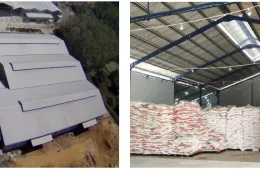 NPGF: Keberlangsungan Usaha yang Berkelanjutan
NPGF: Keberlangsungan Usaha yang BerkelanjutanKabupaten Gresik, 26 September 2023 – PT Nusa Palapa Gemilang Tbk (Kode Saham: “NPGF” atau “Perseroan”) ingin memberikan penjelasan atas berbagai pertanyaan terkait kelangsungan usaha dan prospek Perseroan ke depan. Sejak bulan September 2022, Perseroan mulai melakukan proses pembangunan pabrik baru yang berlokasi di Kecamatan Panceng, Gresik berupa bangunan pabrik, 2 set mesin dry granulation yang lebih efisien dan sarana pendukung lainnya dengan total investasi sebesar Rp 60 Miliar. Proses pembangunan tersebut telah terselesaikan pada bulan Juli 2023. Pembangunan pabrik di Kabupaten Gresik diharapkan dapat memberikan dampak positif bagi perekonomian lokal melalui terciptanya peluang kerja bagi masyarakat setempat.
Perseroan telah beroperasi secara komersial dan menerima pesanan pupuk dari sejumlah pelanggan korporasi (Business to Business atau “B2B”). Saat ini, pesanan pupuk sedang dalam tahap penyelesaian proyek produksi dan pengiriman. Dengan demikian, ditargetkan hingga Kuartal III tahun ini, produksi Perseroan telah full capacity dengan total nilai pesanan sekitar Rp 30 Miliar. Selain itu, untuk memastikan keberlangsungan usaha dan pertumbuhan pendapatan, Perseroan akan melakukan berbagai strategi, salah satunya melalui pengembangan pasar. Perseroan meyakini bahwa masih banyak ruang untuk tumbuh, terutama di free market segmen perkebunan maupun non perkebunan baik untuk tanaman kelapa sawit maupun hortikultura. Kedepannya, Perseroan selain menerapkan pola bisnis B2B, juga mengembangkan pasar dengan model bisnis Business to Consumer (B2C) sebagai wujud komitmen dalam menjaga kelangsungan usaha jangka panjang Perseroan agar dapat bersaing dan adaptif terhadap dinamika industri.
Perseroan telah mengumumkan Laporan Keuangan Konsolidasian Interim untuk periode enam bulan yang berakhir pada tanggal 30 Juni 2023 dan 30 Juni 2022. Per 30 Juni 2023, total liabilitas Perseroan mencapai Rp 32,2 Miliar, menurun 82% dibandingkan 30 Juni 2022 yang dilaporkan sebesar Rp 195,7 Miliar. Penurunan liabilitas yang signifikan dipengaruhi oleh pelunasan utang bank yang terlalu besar dan telah membebani kinerja laba bersih Perseroan. Jika dilihat perbandingan kondisi keuangan melalui nilai Debt to Equity Ratio (DER) pada tanggal 30 Juni 2023 dan 30 Juni 2022 sebesar 0,17 dan 0,85 menunjukkan penurunan risiko keuangan dan kondisi yang semakin membaik. Perseroan berupaya untuk terus meningkatkan produktivitas dan profitabilitas dengan mengelola biaya secara lebih efisien dan penyesuaian ketersediaan dana dengan kapasitas produksi di pabrik baru sehingga Perseroan tidak memiliki peningkatan cost of capital.
Tentang PT Nusa Palapa Gemilang Tbk
Perseroan telah beroperasi sejak tahun 2001 dan bergerak di bidang usaha produksi, pemasaran, dan perdagangan pupuk buatan majemuk hara makro primer. Pada tahun 2023, PT Nusa Palapa Gemilang Tbk memproduksi pupuk NPK dengan sistem dry granulation. NPGF terdaftar secara publik di Bursa Efek Indonesia pada tanggal 14 April 2021.
Untuk informasi lebih lanjut, silahkan hubungi
Sekretaris Perusahaan
T +6231 8485665 | F +6231 8495095
corporatesecretary@ptnpg.com
www.ptnpg.com
Siaran pers ini telah disiapkan oleh PT Nusa Palapa Gemilang Tbk. ("NPGF") dan diedarkan hanya untuk tujuan informasi umum dan bukan merupakan rekomendasi perihal saham NPGF. NPGF tidak bertanggung jawab atas konsekuensi yang timbul sebagai akibat dari ketergantungan pada keseluruhan atau sebagian dari isi siaran pers ini dan baik NPGF maupun Perusahaan afiliasinya dan karyawannya masing-masing dan agen tidak menerima tanggung jawab atas segala kesalahan, kelalaian serta ketidakakuratan yang mungkin timbul.
..
Perseroan telah beroperasi secara komersial dan menerima pesanan pupuk dari sejumlah pelanggan korporasi (Business to Business atau “B2B”). Saat ini, pesanan pupuk sedang dalam tahap penyelesaian proyek produksi dan pengiriman. Dengan demikian, ditargetkan hingga Kuartal III tahun ini, produksi Perseroan telah full capacity dengan total nilai pesanan sekitar Rp 30 Miliar. Selain itu, untuk memastikan keberlangsungan usaha dan pertumbuhan pendapatan, Perseroan akan melakukan berbagai strategi, salah satunya melalui pengembangan pasar. Perseroan meyakini bahwa masih banyak ruang untuk tumbuh, terutama di free market segmen perkebunan maupun non perkebunan baik untuk tanaman kelapa sawit maupun hortikultura. Kedepannya, Perseroan selain menerapkan pola bisnis B2B, juga mengembangkan pasar dengan model bisnis Business to Consumer (B2C) sebagai wujud komitmen dalam menjaga kelangsungan usaha jangka panjang Perseroan agar dapat bersaing dan adaptif terhadap dinamika industri.
Perseroan telah mengumumkan Laporan Keuangan Konsolidasian Interim untuk periode enam bulan yang berakhir pada tanggal 30 Juni 2023 dan 30 Juni 2022. Per 30 Juni 2023, total liabilitas Perseroan mencapai Rp 32,2 Miliar, menurun 82% dibandingkan 30 Juni 2022 yang dilaporkan sebesar Rp 195,7 Miliar. Penurunan liabilitas yang signifikan dipengaruhi oleh pelunasan utang bank yang terlalu besar dan telah membebani kinerja laba bersih Perseroan. Jika dilihat perbandingan kondisi keuangan melalui nilai Debt to Equity Ratio (DER) pada tanggal 30 Juni 2023 dan 30 Juni 2022 sebesar 0,17 dan 0,85 menunjukkan penurunan risiko keuangan dan kondisi yang semakin membaik. Perseroan berupaya untuk terus meningkatkan produktivitas dan profitabilitas dengan mengelola biaya secara lebih efisien dan penyesuaian ketersediaan dana dengan kapasitas produksi di pabrik baru sehingga Perseroan tidak memiliki peningkatan cost of capital.
Tentang PT Nusa Palapa Gemilang Tbk
Perseroan telah beroperasi sejak tahun 2001 dan bergerak di bidang usaha produksi, pemasaran, dan perdagangan pupuk buatan majemuk hara makro primer. Pada tahun 2023, PT Nusa Palapa Gemilang Tbk memproduksi pupuk NPK dengan sistem dry granulation. NPGF terdaftar secara publik di Bursa Efek Indonesia pada tanggal 14 April 2021.
Untuk informasi lebih lanjut, silahkan hubungi
Sekretaris Perusahaan
T +6231 8485665 | F +6231 8495095
corporatesecretary@ptnpg.com
www.ptnpg.com
Siaran pers ini telah disiapkan oleh PT Nusa Palapa Gemilang Tbk. ("NPGF") dan diedarkan hanya untuk tujuan informasi umum dan bukan merupakan rekomendasi perihal saham NPGF. NPGF tidak bertanggung jawab atas konsekuensi yang timbul sebagai akibat dari ketergantungan pada keseluruhan atau sebagian dari isi siaran pers ini dan baik NPGF maupun Perusahaan afiliasinya dan karyawannya masing-masing dan agen tidak menerima tanggung jawab atas segala kesalahan, kelalaian serta ketidakakuratan yang mungkin timbul.
..

 PT Nusa Palapa Gemilang Tbk
PT Nusa Palapa Gemilang TbkSince its establishment in 2001 until now, the company has grown and developed very proudly.
KONTAK INFORMASI
Head Office and Factory:
Jl. Raya Daendles KM 56, Desa Banyutengah, Kecamatan Panceng, Kabupaten Gresik, Jawa Timur
Jl. Raya Daendles KM 56, Desa Banyutengah, Kecamatan Panceng, Kabupaten Gresik, Jawa Timur
© 2021 - Official Site of PT Nusa Palapa Gemilang Tbk
Powered by IKT




